

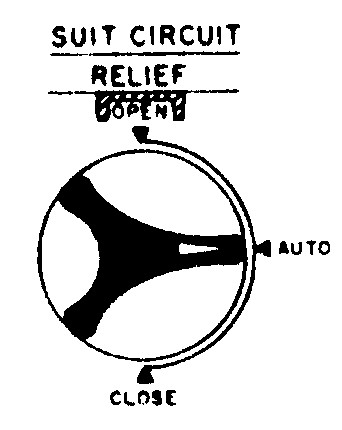
Suit Gas Diverter Valve The suit gas diverter valve is a manually operated, two-way valve (one inlet and two outlets) with a solenoid override in one direction. The valve is on the ECS package above the oxygen control module. When the valve handle is pushed into the cabin position, oxygen is directed into the cabin; pulling the valve handle to the egress position shuts off flow to the cabin.
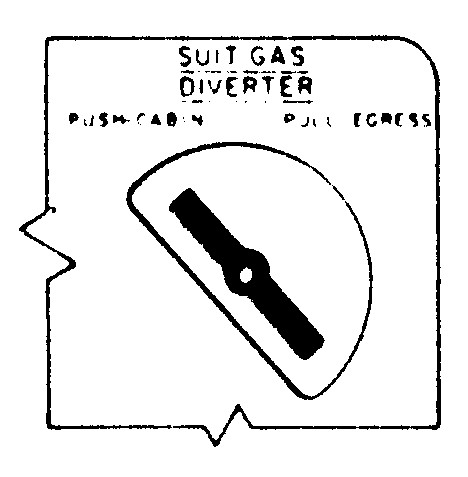
Cabin Gas Return Check Valve The cabin gas return check valve is a spring-loaded, flapper-type valve. The valve has automatic (AUTO), OPEN, and EGRESS (closed) positions. In the automatic position, the valve automatically permits cabin gas to return to the suit circuit. When the cabin is depressurized, the suit circuit pressure closes the valve, preventing back flow into the cabin. The open and egress positions provide manual override of the automatic position.
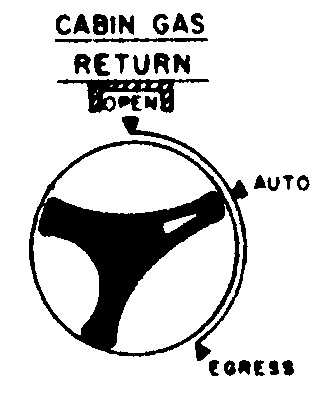
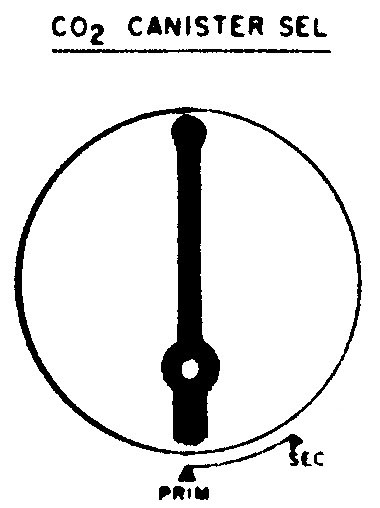
Suit Circuit Fans The suit circuit fans maintain the circulation of conditioned oxygen in the suit circuit. Each suit circuit fan is operated by a 28-volt d-c brushless motor, and each fan moves approximately 24 cfm at 25,000±500 rpm. Fan operation is controlled by the suit fan selector switch.
Suit Circuit Sublimator The sublimator rejects suit circuit heat to space if the suit circuit heat exchanger is inoperative. It has a water inlet and a stream outlet that is vented overboard. Water and suit circuit gas both make a single pass through the unit, which comprises a stack of modules of several layers of porous plates, water, steam, and suit circuit gas passages.
Suit Circuit Heat Exchanger The suit circuit heat exchanger is a duct-shaped unit of aluminum plate-and-fin construction. It has a single pass for both the coolant and the suit circuit gas and is used to remove excess heat in the ARS. Heat is transferred to the HTS coolant supplied to the heat exchanger.
Water Separator Selector Valve The water separator selector valve is a manually operated, flapper-type valve that enables selection of either of two water separators. The valve handle is pushed in for separator No. 1 and pulled for separator No. 2.
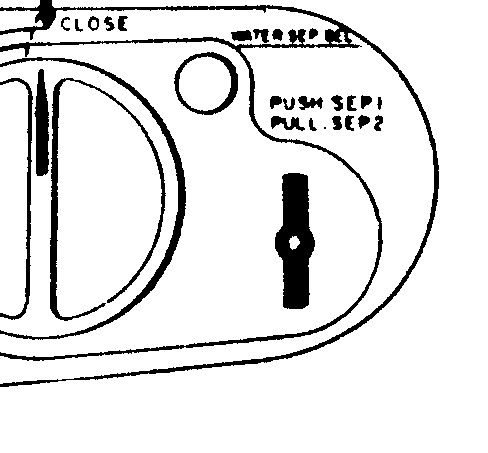
Suit Circuit Regenerative Heat Exchanger The suit circuit regenerative heat exchanger is of the aluminum plate-and-fin type. Heat from the circulating warm coolant is transferred to the oxygen, which makes a single pass through the unit while the coolant makes two passes.
Suit Temperature Control Valve The suit temperature control valve is a manually operated diverter valve that controls coolant flow through the suit circuit regenerative heat exchanger. The valve has two positions, one to increase the temperature, the other to decrease the temperature.
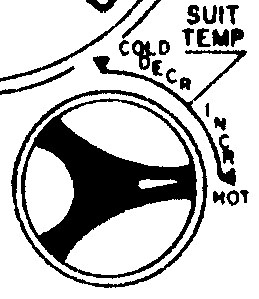
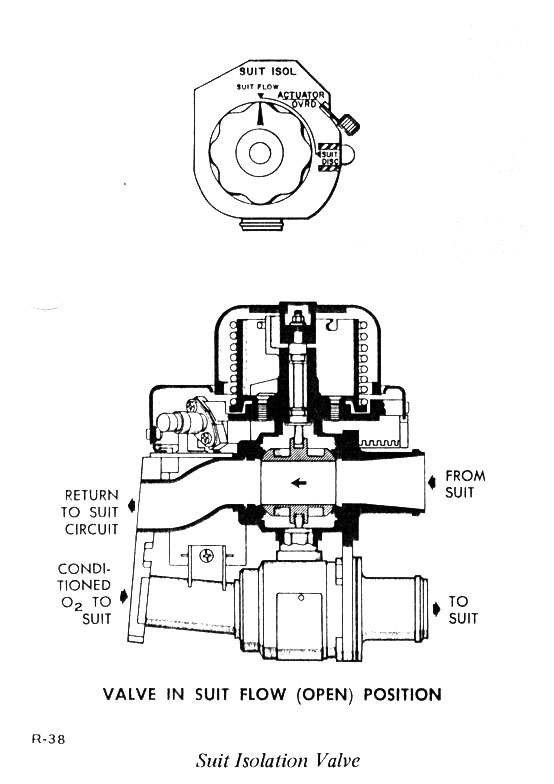
Carbon Dioxide Partial Pressure Sensor The carbon dioxide partial pressure sensor, in the suit circuit assembly, is a single-beam, dual-wavelength, filter photometer with ratio readout. The sensor operates on the infrared-absorption principle. It measures the amount of infrared energy absorbed by the carbon dioxide in a gas sample that passes through the sensor, by comparing transmitted energy of two different wavelengths in the infrared spectrum. (One wavelength is absorbed by carbon dioxide; the other is a reference.) This establishes an amplified ratio signal that is indicated as a d-c voltage proportional to the partial pressure of carbon dioxide in the gas sample.
The sensor has two sections: optics and electronics. The optics section has the infrared energy source (a small tungsten lamp), a collimating lens, a lens that reimages the source on the dual filter, an aperture to fix the source image on the dual filter, and a lens that reimages the chopped and filtered source image onto the detector target. The electronics section detects and decodes the signal, computes the ratio and, then, reads out a continuous d-c voltage proportional to the partial pressure of carbon dioxide in the gas sample. The sensor provides an electrical signal to the PART PRESS C02 indicator and a telemetry signal to indicate the carbon dioxide level in the gas supplied to the astronauts.
Water-Glycol Heat Exchanger The water glycol heat exchanger transfers heat from the warm water returning from the LCG to the coolant of the heat transport section. This heat exchanger is of the crosscounterflow, single-pass water and multipass coolant type.
Liquid Garment Cooling Valve The liquid garment cooling valve is a manually operated diverter valve that controls water flow to the water-glycol heat exchanger. Part or all of the water may be manually diverted around the heat exchanger to provide varying degrees of cooling, depending on astronaut needs.
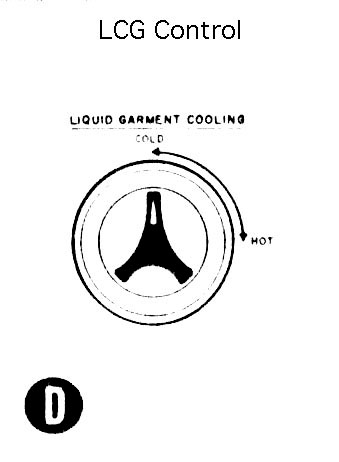
Water Pump The water pump is of the diaphragm type; it circulates water through the suit liquid cooling assembly. A voltage regulator steps down the LM-supplied 28 volts dc to 16±1 volts dc for pump operation.
Portable Recharge Adapter The portable recharge adapter serves as the connection between the PLSS drink line and the multiple water connector of the suit liquid cooling system. Bleed-off capability is provided in the adapter to relieve pressure in the event of overfilling of the system. Both astronauts are disconnected from the cooling system when recharging.
Suit Umbilical Water Hoses The water umbilical hoses transport water between the LCG and the suit liquid cooling assembly. The hoses are flexible silicon rubber, covered with Beta cloth.
Multiple Water Connector The multiple water connectors are quick disconnects that connect the water umbilical hoses to the LCG receptacle on the astronauts outer suit. The connectors provide dual flow into, and out of, the LCG. Poppet valves minimize leakage during connecting and disconnecting.